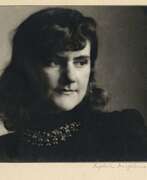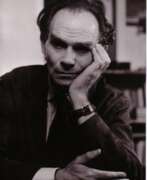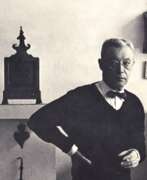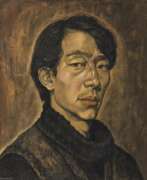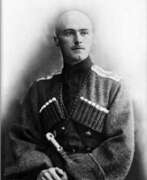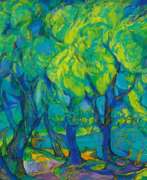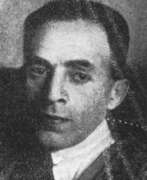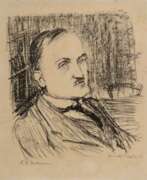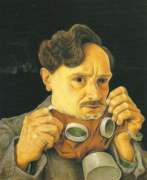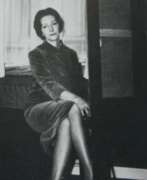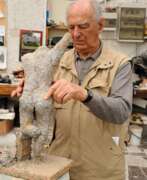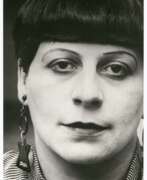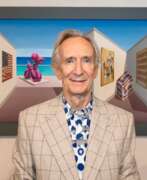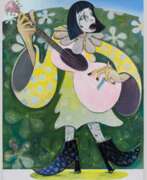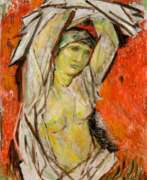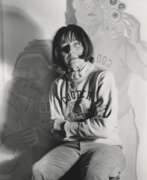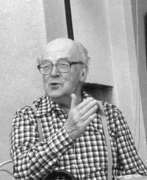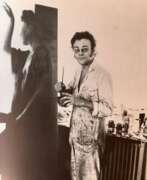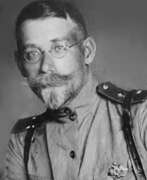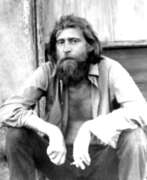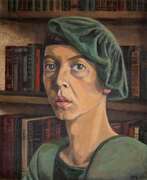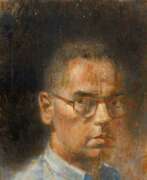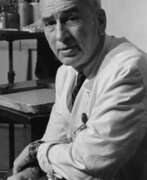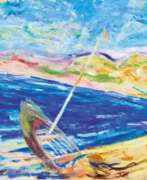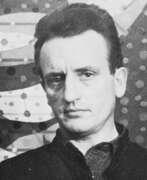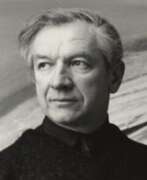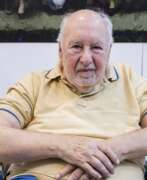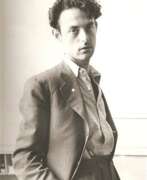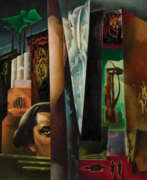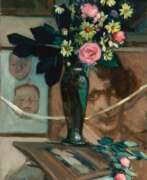Still life Surrealism
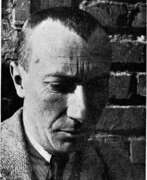

Jean Arp, born Hans Peter Wilhelm Arp, was a German and French poet, painter, graphic artist and sculptor. one of the founders of the Dada movement in Zurich.
Arp used abstract forms in his work and experimented with different materials such as wood, metal and stone. He was also known for his poetic works, in which he applied a method of randomly selecting words, called the "clutter method". Arp believed that this method helped him express his thoughts more precisely and originally. Arp's influence on the arts is still significant today.
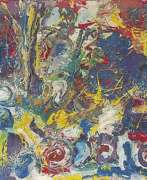

Ernst Rudolf Baerwind was a German painter. Baerwind studied at the art academies in Munich, Berlin and Paris. Baerwind's work was initially based on early German Expressionism. After a surrealist phase, he was influenced in Paris by the painting of the École de Paris and by Informel and then found his way to the International Style.
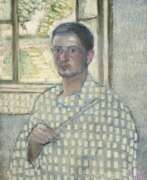

Vladimir Davidovich Baranov-Rossine (Russian: Владимир Давидович Баранов-Россине) was a master of the Russian avant-garde, a prolific painter, sculptor, and inventor, whose work significantly contributed to the Cubo-Futurism movement. Born on January 1, 1888, in Kherson, he was originally named Shulim Wolf Leib Baranov but is best known by his pseudonym, Daniel Rossine. His early artistic education took place in Odessa and then at the St. Petersburg Academy of Arts, laying the groundwork for his future as a revolutionary artist.
In 1910, Baranov-Rossine moved to Paris, a pivotal move that introduced him to the burgeoning European avant-garde scene. It was there, alongside other notable artists such as Marc Chagall, Osip Zadkine, Alexander Archipenko, and Chaim Soutine, that he became an inhabitant of the famous Parisian house "La Ruche." His innovative work, particularly the invention of the Optophonic Piano, which projected colors in sync with music, underscored his commitment to blending art and technology, a hallmark of his career.
Tragically, Baranov-Rossine's life was cut short when he was arrested by the Gestapo in 1943 and subsequently died in Auschwitz in 1944. Despite his untimely death, his legacy lives on through his contributions to modern art and technology. His works can be found in various museums and galleries, celebrated for their vibrant expression and avant-garde techniques that continue to inspire artists and collectors alike.
For those intrigued by Vladimir Davidovich Baranov-Rossine's pioneering work and its lasting impact on the art world, signing up for updates on new product sales and auction events related to this avant-garde master is highly recommended. This ensures enthusiasts and collectors are always informed about the latest opportunities to engage with Baranov-Rossine's remarkable legacy.


Volker Böhringer was a German painter and graphic artist.
He was a significant representative of the "New Objectivity. In his paintings and graphics Böhringer turned to socially critical representational themes, the theme of his early works being industrial landscapes. Böhringer refused to join the League of German Artists (VBKD), so he was forbidden to exhibit his work. Despite his secluded life, he received critical acclaim, and his work was shown in major public exhibitions of German modern art at the Art Museum Basel in 1937 and in Zurich in 1949. In the 1950s he increasingly turned to religious themes in his paintings.
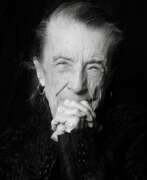

Louise Joséphine Bourgeois was a French-American artist. Although she is best known for her large-scale sculpture and installation art, Bourgeois was also a prolific painter and printmaker. She explored a variety of themes over the course of her long career including domesticity and the family, sexuality and the body, as well as death and the unconscious. These themes connect to events from her childhood which she considered to be a therapeutic process. Although Bourgeois exhibited with the Abstract Expressionists and her work has much in common with Surrealism and Feminist art, she was not formally affiliated with a particular artistic movement.
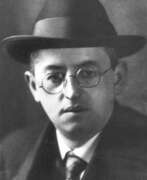

Josef Čapek was a Czech artist, writer, and journalist. He was the younger brother of writer Karel Čapek. Josef Čapek studied at the School of Applied Arts in Prague and later in Paris, where he was influenced by Cubism and Surrealism.
Čapek was a prolific artist, working in various mediums including painting, printmaking, and illustration. He is perhaps best known for his work in the area of puppetry, having created a number of puppet shows that were popular in Czechoslovakia during the 1920s and 1930s. His puppets were known for their expressive faces and whimsical designs.
Čapek was also a writer and journalist, and he wrote plays, essays, and articles for various newspapers and magazines. He was a member of the Czechoslovakian avant-garde group Devětsil, which promoted modern art and literature in the country.
During World War II, Čapek was arrested by the Nazis for his anti-fascist views and was sent to the Bergen-Belsen concentration camp. He died there in 1945, just weeks before the camp was liberated by Allied forces.
Čapek's legacy as an artist and writer is significant, and he is considered one of the most important Czech artists of the 20th century. His work is represented in many collections around the world, including the National Gallery in Prague and the Museum of Modern Art in New York.
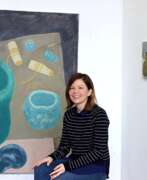

Ginny Casey is a contemporary American artist. Ginny Casey’s contemporary surrealistic paintings capture invented spaces occupied by objects distorted and rendered uncanny—tools, houseware items, and the occasional disembodied hand. In her richly colored still lifes, inanimate objects appear alive and suggest psychological or dream states. An MFA graduate of the Rhode Island School of Design, Casey has exhibited widely in New York City and beyond. The Institute of Contemporary Art at the University of Pennsylvania hosted a critically acclaimed exhibition of her paintings in 2017. While they focus on casually assembled everyday objects, Casey’s canvases pull viewers in with suggestive narratives and spatial depth. Her works can also be playful and self-referential, with clusters of scissors, vessels, palette knives, and other studio necessities that appear in conversation.
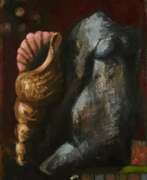

Peter Chevalier is a German painter whose paintings and drawings are close to surrealism. In the 1980s, Chevalier juxtaposed the realistic with the abstract in his paintings. Clearly configured individual but combined things (houses, airplanes, stumps of columns, light bulbs, bones, etc.) dominated, which – as if one were cutting out illustrations from magazines and reassembling them as a collage – are inconsistent in their proportions in the pictorial context.
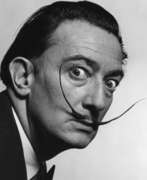

Salvador Dalí, a Spanish Surrealist painter and printmaker, is celebrated for his vivid and imaginative works that delve into subconscious imagery. Born on May 11, 1904, in Figueres, Catalonia, Spain, Dalí's early exposure to Impressionism and Renaissance masters significantly influenced his artistic development. His education in fine arts in Madrid further shaped his style, leading him to experiment with Cubism and avant-garde movements. In the late 1920s, Dalí embraced Surrealism, joining the Surrealist group in 1929 and rapidly becoming one of its most prominent figures.
Dalí's most famous work, "The Persistence of Memory," completed in 1931, epitomizes the Surrealist movement with its iconic melting clocks symbolizing the fluidity of time. His artistic repertoire was diverse, including painting, graphic arts, film, sculpture, design, and photography, often incorporating themes of dreams, the subconscious, sexuality, religion, and science. Despite his remarkable artistic contributions, Dalí's eccentric and flamboyant public persona often overshadowed his work. He faced criticism for his public support of the Francoist regime and the authenticity of some of his late works.
Dalí's legacy is preserved in major museums, notably the Dalí Theatre-Museum in Figueres and the Salvador Dalí Museum in St. Petersburg, Florida. These institutions showcase his extensive and varied body of work, illustrating his profound impact on Surrealism, pop art, and contemporary artists.
If you're captivated by the surreal world of Salvador Dalí and want to stay informed about new sales and auction events featuring his works, sign up for our updates. Our service is tailored specifically for art collectors and experts, providing timely information and insights into the vibrant market of Dalí's art. Remember, this subscription is focused solely on bringing you the latest in product sales and auction events related to Salvador Dalí. Don't miss out on the opportunity to enrich your collection with pieces from one of the most influential surrealists of all time. Sign up now and be the first to know about these exclusive events.
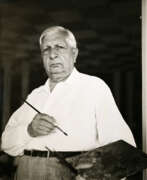

Giuseppe Maria Alberto Giorgio de Chirico, an Italian artist renowned for his profound influence on the Surrealist movement, stands as a seminal figure in 20th-century art. Born in Volos, Greece, in 1888, de Chirico was a visionary painter, sculptor, and writer whose works profoundly altered the landscape of modern art. His paintings, characterized by their dreamlike quality, enigmatic compositions, and the juxtaposition of classical and modern elements, delve into the mysteries of the subconscious, exploring themes of nostalgia, metaphysics, and the uncanny.
De Chirico's art is distinguished by its unique blend of classical motifs with surreal, dreamlike atmospheres, creating a sense of profound mystery and unease. His most famous works, such as "The Enigma of an Autumn Afternoon" and "The Melancholy of Departure," exhibit deserted cityscapes filled with elongated shadows, enigmatic figures, and classical architecture, which became hallmarks of his style. These paintings not only prefigured the Surrealist movement but also influenced countless artists with their exploration of the psyche, the distortion of space, and the play of light and shadow.
His impact on culture and art is undeniable, with his works housed in prestigious museums and galleries worldwide, including the Museum of Modern Art in New York and the Tate Modern in London. De Chirico's ability to evoke the mysterious interconnection between the ancient and the modern through his art continues to captivate collectors and experts in the fields of art and antiques. His innovative approach to painting and sculpture has solidified his position as a key figure in the development of modern art.
For collectors and enthusiasts keen on exploring the depths of 20th-century art and the enigmatic world of Giuseppe Maria Alberto Giorgio de Chirico, staying informed about new discoveries, auction events, and sales of his works is essential. We invite you to sign up for updates to ensure you never miss an opportunity to engage with the enduring legacy of this remarkable Artist. This subscription is your gateway to the latest news related to de Chirico, focusing exclusively on product sales and auction events associated with his influential oeuvre.
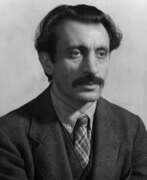

Arshile Gorky was an Armenian-American painter who had a seminal influence on Abstract Expressionism. He spent the last years of his life as a national of the United States. Along with Mark Rothko, Jackson Pollock and Willem de Kooning, Gorky has been hailed as one of the most powerful American painters of the 20th century. The suffering and loss he experienced in the Armenian genocide had crucial influence at Gorky’s development as an artist.


Yozo Hamaguchi was a Japanese artist and copperplate engraver who revived the almost forgotten technique of mezzotint by the 20th century.
He studied at the Tokyo University of Art, traveled to Europe, worked in Paris, and participated in exhibitions. Hamaguchi innovatively inserted bright colors into his black-and-white mezzotints, producing surreal and abstract paintings.


Heinrich Hoerle was a notable German artist, distinguished for his contributions to the constructivist movement and the New Objectivity movement. Born in Cologne, Heinrich Hoerle was largely self-taught, developing a unique style after his experiences in World War I and his involvement in the Cologne Dada scene. His works often depicted generic figures in rigid poses or profiles, reflecting his influences from Russian constructivism, French cubism, and the Dutch De Stijl movement. Hoerle co-founded the artist group Stupid and published influential series like the Krüppelmappe (Cripples Portfolio), exploring themes of disability and war's human toll.
His art, which includes pieces like "Denkmal der unbekannten Prothesen," is preserved in various public collections, including Museum Ludwig in Cologne and the Von der Heydt Museum in Wuppertal. Despite facing condemnation by the Nazis, Hoerle's legacy endures through his thought-provoking works that continue to be celebrated and discussed in academic circles, as evidenced by events like the gallery talk at Harvard Art Museums focusing on his Cripple Portfolio series.
For collectors and art enthusiasts, understanding Heinrich Hoerle's impact on modern art provides a valuable perspective on the interplay between art, society, and history. If you're keen on delving deeper into Heinrich Hoerle's artistic journey and wish to stay updated on related auctions and exhibitions, consider subscribing for updates on new product sales and auction events pertaining to his works.
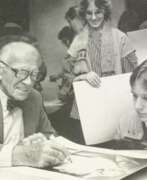

Horst P. Horst, a German-American fashion photographer, is renowned for his significant contributions to the art and fashion industry. Born in 1906, Horst's career spanned several decades, during which he became famous for his distinct style that skillfully blends elements of surrealism, classicism, and avant-garde artistry. His work, characterized by meticulous preparation and an innovative use of lighting, frequently avoided the use of filters and shadows, focusing instead on the subject with an almost architectural precision.
Horst P. Horst's legacy in fashion photography is underscored by his famous portraits, including the iconic 1942 image of Marlene Dietrich, and his exploration of the high society lifestyle through his collaborations with Vogue editor Diana Vreeland. These projects featured portraits of illustrious figures from the realms of royalty, art, fashion, and high society, such as Andy Warhol, Jacqueline Kennedy Onassis, and Yves Saint Laurent, showcasing Horst's ability to navigate the glamorous and intimate worlds of his subjects.
His work extended beyond portraiture to include interior design photography, as seen in his documentation of notable interiors for magazines like House & Garden and Vogue. Horst's photographs often served as a bridge, introducing the public to the works of contemporary artists and designers through his editorial and commercial assignments.
Throughout his career, Horst received critical acclaim, with major retrospectives of his work being held at prestigious venues such as the International Center of Photography in New York, the Louvre in Paris, and the National Gallery in London. These exhibitions highlighted his contributions to fashion, portraiture, and art photography, cementing his status as one of the most influential photographers of the 20th century.
For those interested in the evolution of fashion photography and the intersection of art and culture, Horst P. Horst's work remains a significant point of study and admiration. Collectors and experts in art and antiques are encouraged to explore his extensive portfolio, which continues to inspire and influence the fields of photography and fashion design.
If you wish to stay informed about upcoming sales and auction events related to Horst P. Horst, consider signing up for updates. This subscription will ensure you're at the forefront of the market for his enduring and captivating works.
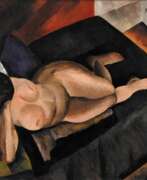

Moïse Kisling was a Polish-born French painter renowned for his contributions to modern art, particularly his highly stylized and evocative portraits. Born in Kraków in 1891, Kisling moved to Paris at the age of 19, quickly immersing himself in the vibrant artistic community of Montmartre and Montparnasse. His work, characterized by bold colors and dynamic compositions, spans a variety of themes, including landscapes, still lifes, and nudes, reflecting influences from Cubism and Post-Impressionism.
Kisling's artistry is celebrated for its unique blend of realism and abstraction, marked by a fluid, colorful style that evolved from his early influences, including Cezanne and Cubism. He was a central figure in the School of Paris, engaging with contemporaries such as Pablo Picasso, Georges Braque, and Amedeo Modigliani, the latter of whom he shared a close friendship and mutual artistic admiration. Modigliani's portraits of Kisling underscore their deep personal and professional bond. Notable works by Kisling include "La Sieste à Saint-Tropez," "Portrait du peintre (Autoportrait)," and "Le pêcheur," showcasing his versatility and skill in capturing the essence of his subjects.
During World War II, Kisling's Jewish heritage forced him to flee to the United States, where he continued to exhibit his work in New York City and California before returning to France after the war. His legacy is preserved in numerous public collections, including the Metropolitan Museum of Art, the National Gallery of Art, and the Brooklyn Museum, among others. This wide recognition attests to his significant impact on the development of modern art.
For collectors and experts in art and antiques, Kisling's work represents a pivotal intersection of cultural and artistic movements of the early 20th century. His paintings are not only visually stunning but also historically significant, embodying the spirit of an era marked by innovation and experimentation. The Musée du Petit Palais in Geneva holds a large collection of his works, offering a comprehensive overview of his artistic journey.
We invite enthusiasts and collectors to stay updated on new discoveries, sales, and auction events related to Moïse Kisling's work. Subscribing to updates ensures you won't miss the opportunity to engage with the rich legacy of this remarkable artist. This subscription is a gateway to exploring the vibrant world of Kisling's art, from his captivating portraits to his lush landscapes and still lifes, all of which continue to enchant and inspire.
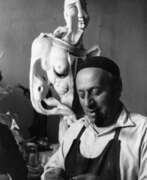

Yervand Kochar (Russian: Ерванд Семёнович Кочар) was an Armenian sculptor and modern artist, renowned for his groundbreaking contributions to the 20th-century art world, particularly as a pioneer of the Painting in Space art movement. Born in Tbilisi, Georgia, in 1899, Kochar's artistic journey led him from his native land to Paris, where his innovative works earned him critical acclaim and a place alongside other avant-garde artists. His creations, characterized by a dynamic blend of sculpture and painting, sought to introduce time as a fourth dimension to art, presenting a novel way of perceiving artistic expressions.
Kochar's most celebrated works, such as the statues of David of Sassoun and Vardan Mamikonian, have become emblematic of Armenian heritage, symbolizing the enduring spirit and cultural richness of Armenia. His masterpiece in painting, "Disasters of War," alongside other significant works, underscores his versatility and mastery over different mediums. The Yervand Kochar Museum in Yerevan, Armenia, serves as a testament to his enduring legacy, housing a vast collection of his works and offering insights into his artistic evolution and the profound impact of his contributions to modern art.
For art collectors and experts, Kochar's work represents not only a pivotal moment in the history of modern art but also an opportunity to engage with the rich tapestry of Armenian cultural identity. His innovative approach to form, space, and time continues to inspire new generations of artists and art aficionados worldwide.
To stay updated on exhibitions and auctions featuring Yervand Kochar's works, sign up for updates. By subscribing, you'll receive alerts on new sales and auction events related to Kochar's art, ensuring you never miss an opportunity to engage with the legacy of this remarkable artist.


Heinz Koppel, a British artist of German origin, found inspiration in Wales where he resided for much of his life. After fleeing Nazi Germany, Koppel studied art in London under Martin Bloch, adopting influences from German Expressionism, Surrealism, and Freudian psychoanalysis. His mystical and fantastical paintings often depicted the Welsh countryside and decaying industrial areas. Koppel's work gained recognition through exhibitions in London galleries, but he remains relatively unknown in his homeland. His contributions to the 56 Group Wales helped elevate modern Welsh art. Many of his works can be found in museums and galleries in South Wales.


Dmitry Mikhailovich Krasnopevtsev (Russian: Дмитрий Михайлович Краснопевцев) was a Soviet and Russian artist of the second half of the twentieth century. He is known as a painter and graphic artist, a representative of "unofficial art" and the so-called Second Russian avant-garde.
Dmitry Krasnopevtsev chose as his main genre "metaphysical still lifes" approaching surrealism, often depicting ceramics, dried plants and shells in melancholy colors. These works developed Baroque motifs of the frailty and unreality of the world. Although for a long time his works were little exhibited in his homeland, they found admirers in other countries such as Austria, Germany, France, Japan, and the United States.
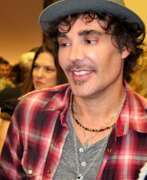

David LaChapelle is an American photographer, music video director and film director. He is best known for his work in fashion, photography, which often references art history and sometimes conveys social messages. His photographic style has been described as "hyper-real and slyly subversive" and as "kitsch pop surrealism". Once called the Fellini of photography, LaChapelle has worked for international publications and has had his work exhibited in commercial galleries and institutions around the world.
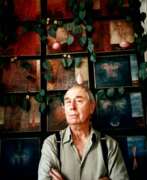

Josef Lehoucka is a Czech surrealist and abstractionist painter.
A close connection between realism and fantasy is a characteristic feature of Josef Lehoucka's paintings. In his youth he was a factory worker, a crane operator, which was reflected in his visual art. Lehoucka often painted fantastically realistic paintings, which he complemented with industrial motifs. His past experiences are recalled in replicas of machines, tongs, and cylinders, geometrized and incorporated into abstract compositions. Against this mechanized reality, however, the Surrealist tradition is strong, bringing elements of chance and the unexpectedness of dreamlike objects and landscapes into the paintings.
Josef Lehoucka's works are represented in the collections of the National Gallery of Prague, the Central Czech Gallery of Prague and others.
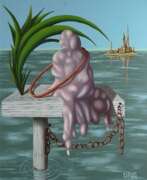

Claude Lepape was a French painter, printmaker, theatre set designer and representative of the Paris School. He was the son of the painter Georges Lepape and studied painting at the Ecole Nationale Superieure des Beaux-Arts in Paris. Claude Lepape's still lifes and portraits convey the artist's intimate understanding of creatures and objects and have a surrealist undertone.


René Magritte, a Belgian artist, was renowned for his significant contributions to the Surrealist movement. His art, known for merging ordinary objects with bizarre, dream-like contexts, captivated the art world. Born on November 21, 1898, in Lessines, Belgium, Magritte's early artistic pursuits were impressionistic, transitioning through Cubism and Futurism influenced by artists like Jean Metzinger. However, his encounter with Giorgio de Chirico's work in 1922 steered him towards Surrealism.
Magritte's career was marked by various phases, each showcasing his evolving style and thematic focus. His initial foray into Surrealism began in 1926 with "The Lost Jockey" and was further solidified during his time in Paris, where he mingled with other prominent Surrealists like André Breton. Despite facing initial criticism and financial challenges, Magritte's unique blend of familiar imagery in unfamiliar contexts, like in "The Empire of Light" and "Time Transfixed," earned him acclaim.
Magritte's distinct visual language, characterized by recurring motifs like bowler hats and apples, and his exploration of reality and illusion, remain influential. His works are displayed in major galleries worldwide, continuing to inspire and intrigue art collectors and enthusiasts.
For collectors and experts in art and antiques, staying informed about Magritte's works and related auction events is crucial. Signing up for updates ensures you're alerted to new sales and events focusing on René Magritte's art, offering unique opportunities to acquire or learn more about his remarkable creations. This subscription will exclusively cover new product sales and auction events related to Magritte, keeping you updated on the most relevant information in the art world.


Ricardo Martínez de Hoyos was a Mexican painter noted for his figurative work on unreal atmospheres. He was one of several children from a very large family to make a mark in his field, along with Oliverio in sculpture and Jorge in acting. His work was exhibited in various parts of the world, featured in collective tours of Mexican art. Individually, he exhibited mostly in Mexico including important venues such as the Museo de Arte Moderno and the Palacio de Bellas Artes, which held a tribute to the artist in 1994. Since his death, a cultural center named after him has been established in the historic center of Mexico City.
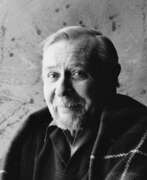

André-Aimé-René Masson was a French artist, celebrated for his profound influence on the world of modern art, particularly in painting and sculpture. Born in 1896, Masson's work is emblematic of the Surrealist movement, although his style evolved across different phases throughout his career. His ability to fuse dream-like imagery with abstract forms set him apart from his contemporaries, making him a pivotal figure in the development of Surrealism and beyond.
Masson's art is characterized by its dynamic forms and the integration of automatic drawing, where the unconscious mind is allowed to express itself without rational oversight. This technique not only foregrounded Surrealism's fascination with the subconscious but also highlighted Masson's unique ability to capture the complexity of human emotion and thought on canvas. His works, such as "The Metamorphosis of the Lovers" and "Battle of Fishes," are not just visual experiences but portals to the intricate layers of the psyche, showcasing his mastery over both form and content.
Notably, André-Aimé-René Masson's contributions extend beyond individual creativity; his works are housed in prestigious museums and galleries worldwide, including the Museum of Modern Art in New York and the Centre Georges Pompidou in Paris. These institutions recognize Masson's art not merely as aesthetic achievements but as cultural landmarks that continue to inspire and provoke. His legacy persists, offering rich insights into the intersections of art, psychology, and philosophy.
For collectors and experts in art and antiques, André-Aimé-René Masson's oeuvre represents a fascinating exploration of the Surrealist movement and its enduring impact on modern and contemporary art. His innovative approach to painting and sculpture invites ongoing discussion and appreciation among enthusiasts and scholars alike. We invite you to sign up for updates on new product sales and auction events related to André-Aimé-René Masson, ensuring you stay informed about opportunities to engage with the remarkable legacy of this pivotal artist. This subscription is your gateway to the forefront of art collection, focusing exclusively on Masson's influential body of work.


Joan Miró, a celebrated Spanish artist, was a master in painting, sculpture, and ceramics, renowned for his unique style that blurred the lines between Surrealism, Fauvism, and Expressionism. Born in Barcelona to a family of a goldsmith and a watchmaker, Miró grew up immersed in the rich cultural heritage of the Barri Gòtic neighborhood. His artistic journey began with drawing classes at the age of seven and continued at the prestigious La Llotja art academy. Despite an initial venture into the business world, Miró's passion for art prevailed, leading him to abandon his clerical career after a nervous breakdown.
Miró's work is noted for its exploration of the subconscious, often depicting a childlike perspective. This approach was both a critique of traditional painting methods and a means of expressing Catalan pride. His art, challenging to categorize, often featured symbolic elements and nationalistic qualities. One of his notable early works, "The Farm," reflects a transition to a more individual style, blending elements of his Catalan roots with broader artistic influences. This piece, later purchased by Ernest Hemingway, encapsulated the essence of Spain in its imagery.
In Paris, Miró joined the Surrealist movement in 1924, where his work began to reflect the influence of automatism, emphasizing spontaneous, automatic, or subconscious creation. He experimented with various mediums, including painting-poetry and collage, and even ventured into set and costume design for Sergei Diaghilev's Ballets Russes.
During World War II, Miró remained in Spain, and his work from this period, including the 22 Constellations series, reflected an interest in the night, music, and stars. His forms became increasingly abstracted, and he experimented with various techniques, often incorporating primary colors and evocative titles.
Miró's career spanned several decades, during which he continually evolved his style and explored new mediums. His contributions to art were recognized with numerous awards and retrospectives, including a major career retrospective at MoMA in 1941 and the Spanish Gold Medal for Fine Arts in 1980. Among his last major works was a tapestry for the World Trade Center in New York City, created in 1974.
For art collectors and enthusiasts, Joan Miró remains a figure of immense interest, not only for his distinct style and contributions to Surrealism but also for his ability to blend poetic imagery with political commentary. To stay updated on new product sales and auction events related to Joan Miró, sign up for our updates and immerse yourself in the world of this extraordinary artist.
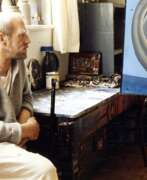

Johann Georg Müller was a German painter and graphic artist. He was studied at the Academy of Fine Arts in Munich.
Müller's work was heavily influenced by the Expressionist and Surrealist movements, and his paintings and graphic works often featured bold colors and abstract, dreamlike imagery. He was known for his use of symbolic motifs and his interest in mythological and religious themes.
During World War II, Müller was drafted into the German army and served on the Eastern Front. After the war, he returned to Munich and resumed his artistic career. He became a member of the German Expressionist group "Die Neue Gruppe" and participated in several exhibitions throughout Europe.
His work continues to be exhibited and studied around the world, and his legacy has had a significant impact on the development of modern and contemporary art in Germany and beyond.
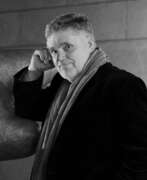

Markus Oehlen is a German artist and musician.
Markus Oehlen graduated from the Düsseldorf Academy of Fine Arts, where his mentor was Alfonso Hüppi. Oehlen was one of the main members of the German "New Wilde" (Neue Wilde) art movement, which flourished in the 1980s and was characterized by the use of punk style elements in opposition to the then prevalent minimalism.
Oelen is constantly refining the technique of his paintings and also working in parallel on sculptures and musical projects. His new works are increasingly influenced by the perceptual experiments of op-art with their interference of printed images, which emerge as lattice patterns from below and above the image layers. Alongside forms oriented towards a computer aesthetic, this brings elements of the avant-garde into his images. By rearranging the individual compositional elements of the canvas, Oelen creates surrealist still lifes, playing with the notion of chance and suggesting bizarre narratives.
Markus Oehlen has been a professor at the Academy of Fine Arts in Munich since 2002.
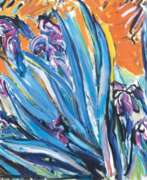

Wilhelm Ohm, full name Wilhelm Friedrich Hubert Ohm, was a German painter, draftsman, sculptor and architect.
Ohm trained in architecture and worked as a government architect and engineer, and studied sculpture and mural painting at the Prussian Academy of Fine Arts in Berlin. From 1923 to 1933 he was a member of the North German Artists' Association. In 1940 Wilhelm Ohm received a Bachelor's degree from the Technical University of Berlin on the colorful redesign of cities, through which he wanted to combine painting and architecture into a unified whole. This idea occupied him throughout his life.
Wilhelm Ohm's work of the 1920s can be stylistically categorized as New Objectivity and Surrealism. After World War II, trying to make up for lost time, he saturates his paintings with color and energy. His later works were done in a post-impressionist style. This applies to his landscapes, nature studies, floral bouquets and fruit compositions.
Wilhelm Ohm's son August Ohm, born in 1943, also became an artist.
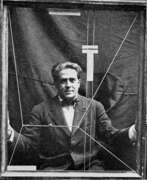

Francis Picabia, born Francis-Marie Martinez de Picabia, was a French avant-garde painter, poet, and typographist, whose work is celebrated for its diversity and innovation. His journey through various art movements, including Impressionism, Cubism, Dadaism, and Surrealism, showcases his refusal to be confined by any one style. Picabia's art is known for its eclectic nature, often blending mechanical elements with organic forms, thereby challenging traditional perceptions of art and beauty.
Picabia's significant contribution to the art world lies not just in his varied artistic output but also in his philosophical approach to creation. He believed in the freedom of expression, often using his art to critique societal norms and the art establishment itself. This rebellious spirit made him a pivotal figure in the Dada movement, where his works were celebrated for their irony and disdain for conventional art values.
Among his notable works, "Amorous Parade" and "I See Again in Memory My Dear Udnie" stand out, housed in prestigious institutions like the Museum of Modern Art in New York. These pieces exemplify Picabia's mastery over blending different elements of art movements, creating works that remain influential to this day. His legacy is not just in the pieces he created but also in his attitude towards art, encouraging future generations to challenge and redefine the boundaries of creativity.
For collectors and experts in art and antiques, Picabia's works represent not only significant artistic achievements but also valuable insights into the evolution of modern art. To stay informed about new product sales and auction events related to Francis Picabia, sign up for updates. This subscription is an essential resource for enthusiasts looking to enrich their collections with pieces from one of the most innovative artists of the 20th century.
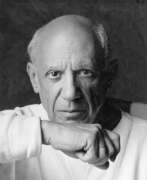

Pablo Ruiz Picasso, a Spanish artist renowned for his revolutionary contributions to the 20th-century art scene, is a figure that resonates profoundly with collectors and art experts. His unique blend of talents in painting, sculpture, printmaking, and ceramic art, infused with his time in France, positioned him as a pivotal character in modern art history.
Picasso's artistic journey was marked by distinct periods, each showcasing his evolving style and genius. His early years were characterized by the Blue Period (1901-1904), followed by the Rose Period (1904-1906), and then the African-influenced Period (1907-1909). Picasso's name is synonymous with Cubism, a movement he co-founded, which significantly altered artistic perspectives and methods. Works like "Les Demoiselles d'Avignon" (1907) and "Guernica" (1937) are emblematic of his cubist legacy, the latter being a poignant anti-war statement that remains influential.
His later years saw a return to more traditional styles, with neoclassical and surrealist influences becoming evident. Works from these phases reflect a deep engagement with mythological themes, as seen in "Faun with Stars" (1955), symbolizing his late-life romance with Jacqueline Roque, his second wife.
Picasso's prolific output and innovative spirit made him a legend in his own time, a status that only grew after his death. His works, housed in major museums and private collections worldwide, continue to captivate and inspire.
As a collector or expert in art and antiques, staying informed about Picasso's works, their auction events, and sales is essential. To stay updated on the latest developments and opportunities related to Pablo Picasso, sign up for our specialized updates. Rest assured, this subscription will focus solely on new product sales and auction events pertaining to Picasso's art, ensuring that you receive only the most relevant and valuable information.


Georges Ribemont-Dessaignes was a French writer and artist associated with the Dada movement.
In addition to numerous early paintings, Ribemont-Dessaignes wrote plays, poetry, manifestos and opera librettos. He contributed to the Dada (and later surrealist) periodical Literature.
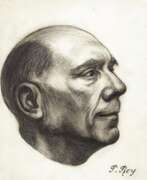

Pierre Roy was a French surrealist painter. He is known for his realistically painted compositions of ordinary objects in unexpected arrangements. After gaining his baccalauréat at the local school he joined a firm of architects before enrolling at the Ecole des Beaux-Arts in Paris. Disappointed with the course, he left to work on the designs for the 1900 Paris Exposition.
His work is classed as surrealism, and is based on assemblages of everyday objects such as shells, vegetables and fruits, woollen reels, ears and seeds, eggs and ribbons arranged to create poetic images.


Kay Sage, birth name Katherine Linn Sage, is an American artist known for her surrealist paintings. Sage began her career as a poet, but later turned to the visual arts, particularly painting, which became her primary means of expression.
Kay Sage's paintings are characterised by dreaminess, the juxtaposition of objects and landscapes, and a mysterious atmosphere. She often depicted desolate landscapes, architectural elements and mysterious structures, creating a sense of unease and ambiguity. Her work often features geometric shapes, unusual angles and an understated colour palette.
Kay Sage was influenced by Surrealism and became associated with the movement. She was inspired by the work of artists such as René Magritte and Yves Tanguy. Her paintings often convey a sense of isolation and introspection, exploring themes of identity, time and the subconscious.


Dennis Scholl, a German painter and graphic artist, has carved a unique space in the contemporary art world. Scholl's journey into art began at the Academy of Fine Arts in Hamburg, where he studied under Franz Erhard Walter and Andreas Slominski. His early artistic explorations were predominantly in monochromatic pencil drawings, distinguishing himself from his contemporaries who were more inclined towards colorful painting.
Dennis Scholl's art invites viewers into a multilayered, enigmatic world. His works are populated with characters that range from the whimsical to the bizarre, each telling a story that is both intimate and elusive. The human figure is a recurring theme in his drawings, often presented in scenarios filled with conflicts and romances. These characters, sometimes drawn from literature and history, or purely from Scholl's imagination, contribute to the narrative depth of his work.
Over the years, Dennis Scholl's art has evolved significantly. His transition from monochrome to color began around 2015, adding a new dimension to his work. He skillfully moved from red chalk to pastels and crayons, eventually transitioning to oil paints in 2017. This evolution in his medium reflects his commitment to artistic growth and exploration.
Dennis Scholl's works have gained international recognition, being featured in numerous group and solo exhibitions across the globe, including in cities like New York, Brussels, Malmö, and London. His art has also found a place in private collections in Switzerland, North America, and Germany.
For collectors and art experts, Dennis Scholl represents an intriguing blend of traditional techniques and contemporary themes. His works are a testament to the enduring power of narrative in art, inviting viewers to delve into stories that are both familiar and mystifying.
Stay updated on Dennis Scholl's latest works and exhibition events by signing up for our newsletter. We provide straightforward information about upcoming sales and auctions featuring Scholl's art, ensuring you stay informed about this remarkable artist.
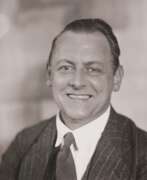

Kurt Schwitters (1887–1948) was a German artist renowned for his multifaceted contributions to modern art, encompassing painting, poetry, graphic design, and installation art. Born in Hanover, Germany, Schwitters developed a unique artistic vision that led to the creation of "Merz," a term he coined to describe his one-of-a-kind approach to art.
The concept of Merz originated from a fragment of the word "Kommerz" (commerce), which Schwitters incorporated into his early collages. This term came to represent his artistic philosophy, characterized by the assemblage of found objects and everyday materials into cohesive compositions. Through Merz, Schwitters sought to blur the boundaries between traditional art forms, integrating elements of Dadaism, Constructivism, and Surrealism.
One of Schwitters' most significant projects was the "Merzbau," an ambitious, evolving installation within his Hanover home. This project began around 1923 and transformed his living space into a labyrinthine structure filled with collages, sculptures, and found objects. The Merzbau was a physical manifestation of his Merz philosophy, embodying the synthesis of art and life. Unfortunately, the original Merzbau was destroyed during a British air raid in 1943.
In addition to his visual art, Schwitters made notable contributions to literature and sound art. His poem "An Anna Blume," published in 1919, is a seminal work that exemplifies his playful use of language and nonsensical style, aligning with the Dada movement's principles. Moreover, his "Ursonate," a sound poem composed between 1922 and 1932, showcases his innovative exploration of phonetic expression and rhythm, pushing the boundaries of traditional poetry.
The rise of the Nazi regime in Germany had a profound impact on Schwitters' life and work. Classified as a "degenerate" artist by the Nazis, he fled to Norway in 1937 to escape persecution. Following the German invasion of Norway in 1940, he sought refuge in the United Kingdom. During his internment at the Hutchinson Internment Camp on the Isle of Man, Schwitters continued to create art, producing over 200 works during his 16 months of confinement.
After his release, Schwitters settled in the Lake District of England, where he embarked on a new Merz construction known as the "Merzbarn." Although he was unable to complete this project due to his death in 1948, the Merzbarn stands as a testament to his unwavering commitment to his artistic vision. Today, Kurt Schwitters is celebrated as a pioneer of modern art, whose innovative techniques and ideas have left an indelible mark on the art world.
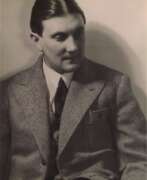

Jindřich Štyrský was a Czech artist, photographer, poet, and writer. He is best known for his contributions to the Surrealist movement in Czechoslovakia during the 1930s and early 1940s.
Štyrský initially trained as a painter, but he soon became interested in photography and began experimenting with the medium in the early 1920s. He became associated with the Czech Surrealist Group in the mid-1930s and became one of its leading figures, alongside fellow artist and writer Toyen.
In addition to his photography, Štyrský was also a prolific writer and poet. He published several books of poetry.
Štyrský's photography is characterized by its surreal and dreamlike qualities, often featuring distorted figures and strange juxtapositions of objects. He also produced a series of photomontages, which combined different photographic elements to create unsettling and enigmatic images.
During World War II, Štyrský was persecuted by the Nazi regime for his art and writings. His work has since been recognized for its contribution to Surrealism in Czechoslovakia and its unique blend of photography, painting, and literature.


Josef Sudek was a Czech photographer known for his poetic images of Prague and its surroundings. He initially studied bookbinding before becoming interested in photography.
Sudek is known for his use of the large format camera, which allowed him to create highly detailed and nuanced images. He often photographed still lifes, landscapes, and architecture, but his most iconic images are his atmospheric images of Prague, which he captured over the course of several decades.
Sudek's photography is characterized by its emphasis on light, shadow, and texture, and his images often have a dreamlike or poetic quality. He also experimented with different printing techniques, including platinum printing, which gave his photographs a soft and velvety texture.
Despite facing numerous challenges throughout his life, including losing an arm in World War I and facing political persecution during the Communist regime in Czechoslovakia. Today, he is considered one of the most important photographers of the 20th century, and his work is held in major collections around the world, including the Museum of Modern Art in New York and the National Gallery in Prague.
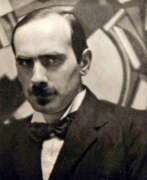

Edward Alexander Wadsworth was an English avant-garde artist, an active participant in the radical "Vorticism" movement that emerged in London just before the First World War. He contributed to the further development of the British avant-garde, bringing to it the ideas of Surrealism. He was a member of such significant creative associations as the Parisian group Abstraction-Création. After the war, the theme of the navy was one of the main themes in his work. Wadsworth painted coastal landscapes, abstracts, portraits and still lifes in tempera and also produced works printed with wood and copper engravings.
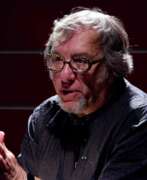

Joel-Peter Witkin is an American photographer who lives in Albuquerque, New Mexico. His work often deals with themes such as death, corpses (and sometimes dismembered portions thereof), often featuring ornately decorated photographic models, including people with dwarfism, transgender and intersex persons, as well as people living with a range of physical features which Witkin is often praised for presenting in poses which celebrate and honor their physiques in an elevated, artistic manner. Witkin's complex tableaux often recall religious episodes or classical paintings.
